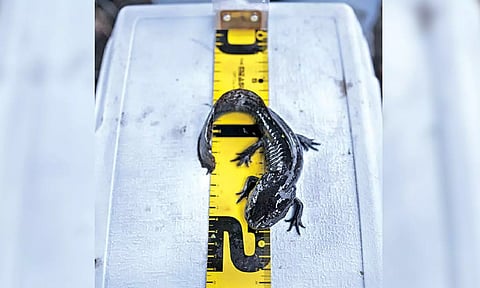

• JENNIE ERIN SMITH
Xochimilco is a large, semi-rural district in the south of Mexico City, home to a vast network of canals surrounding farming plots called chinampas. Starting around A.D. 900, this maze of earth and water produced food for the Xochimilcas, a Nahuatl speaking people who were among the first to populate the region and engineer its wetlands.
Nowadays in the early mornings, farmers — many of them descendants of Xochimilco’s original inhabitants — can be seen loading canoes with lettuces and flowers grown in the rich sediments dredged from the canals. On weekends, hundreds of brightly coloured party boats crowd the waters, full of urbanites seeking escape.
The Mexican axolotl — a dusky amphibian with the remarkable habit of neoteny, or retaining its juvenile body type all its life — once thrived in these canals. Though axolotls have been reproduced widely as lab animals and in the aquarium trade, where they are more often pink or yellow thanks to genetic mutations, it is now questionable whether any significant wild population remains. At last count, a decade ago, there were 35 axolotls per square kilometer in the Xochimilco wetlands, down from thousands in the 1990s. Pollution, urbanization and introduced fish species had made life nearly impossible for them.
In the early 2000s, Luis Zambrano, an ecologist at the National Autonomous University of Mexico, or UNAM, was studying the effects of invasive carp when he was tapped by the government to survey axolotls. After decades of steady environmental degradation in Xochimilco, Mexico wanted to know how many axolotls remained in the species’ last stronghold. Axolotls were of deep cultural importance, a feature of the region’s traditional diet and cosmology. And laboratory biologists all over the world, who for more than a century had used axolotls to study tissue regeneration, worried that their animals were becoming inbred, without a wild population from which to draw new bloodlines.
As an ecologist, Zambrano never entertained any strategy to save the axolotl that did not involve first restoring its habitat. But “this isn’t the middle of Borneo or the great plains of the Serengeti,” he said. The habitat was Mexico City, population 22 million and growing. The number of factors counting against success was staggering.
Springs that historically fed the Xochimilco wetlands were long ago diverted for urban use, replaced by treated wastewater. Introduced carp and tilapia ate axolotl eggs. New roads pushed urbanization ever further south, threatening the last remnants of the unique pre-Columbian farming culture whose canals had sheltered axolotls for over a millennium. Party boats not only brought noise and more pollution but tempted farmers to convert their chinampas to restaurants, bars and soccer fields and to let small canals dry up.
Representations of axolotls occur everywhere in Mexico City — their enigmatic faces grace street murals, handicrafts and even, lately, a 50-peso bill — but the animal’s natural history is unknown. Nearly everything that has been learned about axolotls comes from specimens in tanks.
The only way to save and study the wild axolotl was to promote a renaissance of ancestral farming practices.